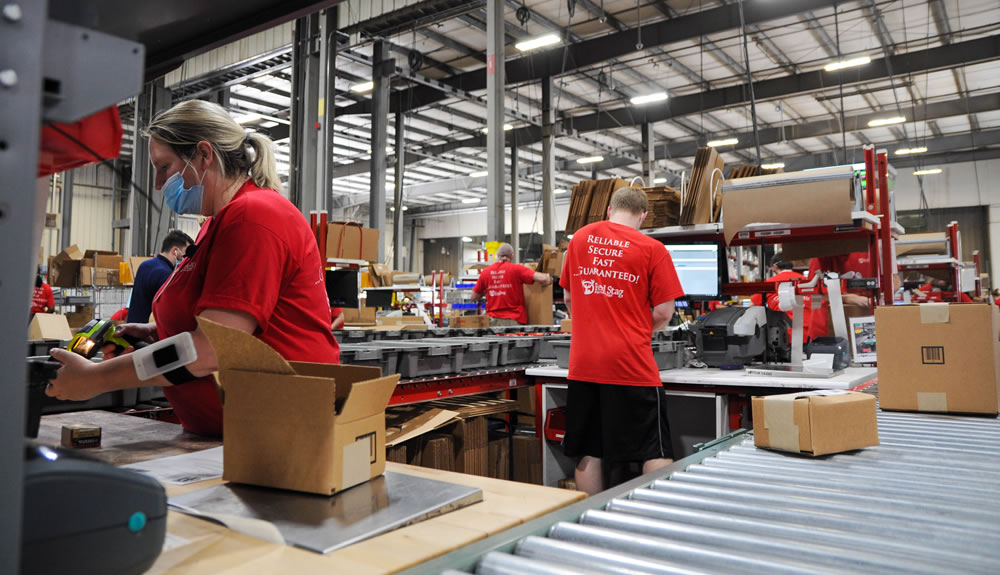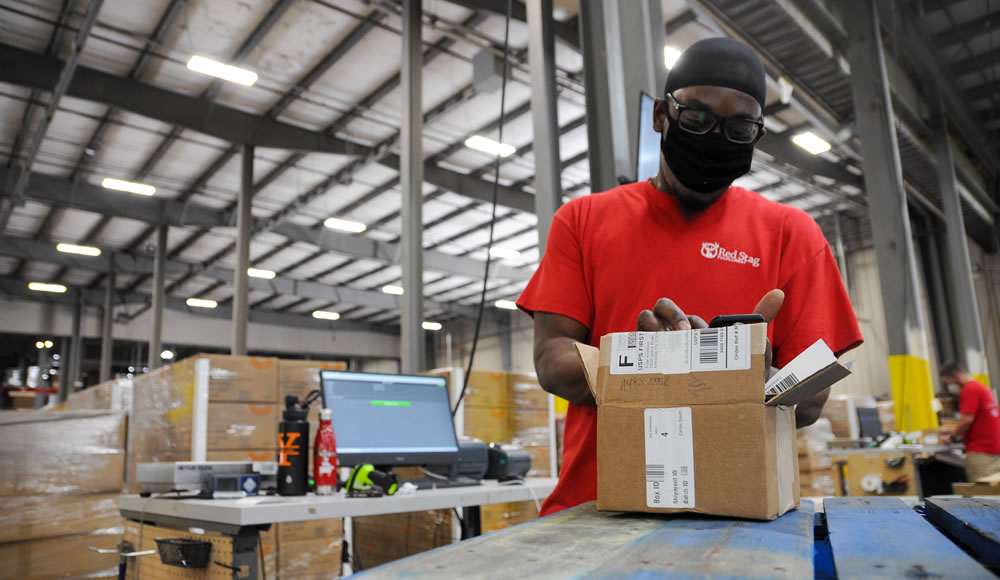This post is by Jake Rheude, the Director of Marketing for Red Stag Fulfillment.
A lot needs to happen to get physical products all the way from the manufacturer, through a warehouse, and into the hands of an online customer.
Order fulfillment is a necessity for an ecommerce business, but understanding and then mastering each part of the process can be difficult. Fulfillment isn’t only about processing each order correctly and at the lowest possible cost, it’s also a major component of customer satisfaction. Doing a great job can result in glowing feedback, and doing a poor job can sink your business very quickly.
Let’s look at the entirety of the fulfillment process, from receiving inventory to storage, pick and pack, order management, shipping and what happens when an order is returned.
What is the fulfillment process?
The fulfillment process is the complete journey that your inventory takes from being received at your warehouse to being shipped out to the customer’s door. It involves the arrival of a freight shipment, breaking it down for storage, receiving orders to process, picking products from shelves, packing orders into boxes, and shipping those boxes out.
If the customer sends the order back then the process works in reverse, receiving shipments at the warehouse and putting the products back into storage.
You can handle the fulfillment process yourself, use an integrated service like Amazon’s FBA, or contract it out to a third-party logistics company (3PL). It’s also common to use a blend of these fulfillment strategies for different products, sales channels or geographical locations. You might have your own warehouse for local orders, for example, and use a partner company with multiple warehouses for online orders.
There are also fulfillment strategies like dropshipping, where the manufacturer or wholesaler sends goods directly to your customer, so you never have to handle the physical product yourself. However, even then, the fulfillment process still takes place – it’s just handled by someone else.
1. Receiving
The receiving process (or inbound shipping) is just what it sounds like. It’s the first part of the fulfillment process and happens when you receive goods from your supplier, often the manufacturer or distributor. Freight shipments are sent to your warehouse, usually via trucks. The goods are offloaded and your warehouse then needs to check them and confirm receipt of the proper items and quantities based on your invoice.
Inventory is then inspected for damage and generally broken down from large packaging into individual units. A warehouse management system (WMS) with barcode scanner support is very useful here. Scanning each item as it is processed helps ensure an accurate count and allows you to verify inventory levels throughout.
2. Putaway and storage
After it is received and the shipment checked, your inventory is moved to pallets or shelves in your warehouse. Keeping identical items together and storing them in designated locations for each SKU will speed up the process of using that inventory.
If your products need processing before they can be shipped out, you might choose to do that before they are put away. This can include bundling separate items to create a new SKU, or creating different multipack sizes of the same item. A scanner and WMS help here as well, by ensuring that products are combined correctly and the new inventory counts reconcile correctly with the original items.
Create time for your team to check goods, put them away, and do spot inventory counts. It will maintain accuracy and help keep things running smoothly. Train your team on these processes, especially how they scan goods and verify them within your system.
If you use special equipment like a forklift, give every warehouse team member training on how to use it and how to work safely around it. Using the right equipment, keeping goods stored in a specific place for each SKU, and training teams on how to move around your warehouse will all make your fulfillment process significantly more efficient.
Once you’ve got the basics, you can expand to more advanced layouts and techniques. These include putting your commonly sold inventory near packing stations, creating one-way lanes for people to walk in, and grouping products so that goods commonly sold together are stored close to each other.
3. Order management
The next step in the fulfillment process usually happens within your software. Order management connects your ecommerce sales channels, such as marketplaces and shopping carts, with your warehouse or 3PL partner. The result is that confirmed orders from all your sales channels are funneled into a single pipeline.
An order management system (OMS) removes the need to download orders from multiple platforms and in different formats, improving speed and accuracy. Your OMS can help define priorities and queue up the orders accordingly, for example by putting expedited orders to the front of the line. The order list is then sent to the warehouse team.
Along with a warehouse management system (or sometimes combined with it), an OMS helps maintain fulfillment speed and accuracy, avoiding mis-picks, incorrect quantities and other issues that lead to customer complaints and returns.
4. Pick and pack
When an order is ready to process, it is handed to your team of pickers – people who literally pick items off your shelves. Pickers take a printed order sheet, or use a mobile app, then find every item on the list. Then they bring all the items to complete an order, or multiple orders, to a packing station.
Packers put the products into appropriately-sized boxes, along with protective materials and any paperwork required. Next, they’ll tape everything up and either print shipping labels or add order barcode labels so the correct shipping can be added at the next stage. Completed packages are brought to shipping stations or directly to the loading dockers, or stacked in cages to be moved in bulk at a later time.

Again, software makes the fulfillment process much more manageable. Warehouse management systems can deliver order sheets to individual pickers to maximize their efficiency. This is especially useful to group orders for products in nearby locations, and to space out work that requires equipment like forklifts or large carts. It helps staff minimize walking distances, and avoid waiting to use equipment that is in limited supply.
A WMS that includes barcode scanning support greatly improves accuracy, because each item can be scanned when it is picked and again when it is packed. This serves as a checklist to ensure that orders are complete, and products don’t get switched between orders.
5. Shipping
Your warehouse may have separate shipping stations, or packing stations may have the ability to get orders ready to ship. Either way, the next step is to measure and weigh each package, and then buy a shipping label so it can be delivered to the end customer.
If you use software to buy shipping from your selected carriers, you can set it to automatically pick the best shipping option to meet delivery requirements while minimizing costs. Checking dimensional weight and actual weight for packages also makes it easier to save on shipping. Order management tools send all the required information to your carrier’s systems, buy shipping, and print the label for each order.
If your OMS is integrated with your sales channels, it can also send tracking details back to the marketplace or shopping cart where the order originated, or notify the customer directly as soon as the order is shipped. You can also use an OMS to monitor the progress of your shipments and set up alerts for any delays or other issues, so customer service staff have all the information they need at hand.
The final step is for all the packages to be stacked into cages ready for collection by the shipping carrier (or carriers) that you use. A printed or electronic manifest may be required, so the carrier knows which parcels are included. This is usually generated by your OMS or shipping software. The carrier then comes to collect the packages and, all being well, the fulfillment process is complete.
6. Returns
Unfortunately, with ecommerce return rates as high as 30%, your warehouse needs to be set up to handle returns just as efficiently and accurately as any other part of the fulfillment process. Your customer service team needs to be ready to communicate with customers about returns, refunds, and exchanges so make sure your returns policy is clear and easy to find. If you sell on marketplaces like Amazon and eBay, you will need to follow the rules they stipulate for returns.
Customer service departments and warehouse teams need training on what types of returns and exchanges are accepted. This might mean that packaging has not been opened and the original tags are still on the item. Of course, you also need to be aware of consumer protection laws, and their rights to receive refunds for defective products or incorrect shipments.
When an order is being returned, you move into an area called “reverse logistics”. This covers the process that begins when the customer asks to return an order. Usually, you’ll need to agree to the return and help the customer send the product back to you. You will need to update your OMS, which may also generate a returns slip and shipping label for the customer to use.
From there, returned goods need to be received and processed. When the return is received, warehouse staff will need to check that the correct product is included and that it is in the condition you expected.

After inspecting the return, as long as everything is as expected, a refund can be sent. Product exchanges follow the same steps except that you will also need to ship out a new order after the return has been processed.
Inventory counts can be easy to overlook in the returns handling process. If someone returns a product and you decide that it can be resold, it needs to be stored at the proper location in the warehouse and the inventory count updated. This helps prevent reordering products that you actually have in stock.
It’s all about the people
The order fulfillment process is very labor-intensive. You will need people to carry out every step and warehouse managers available to provide training, supervision and support. Software makes this easier as you can track metrics for your overall operations as well as individual people. It can help identify where people need to improve and how your company can improve overall.
But at the end of the day, the heart of your warehouse is your team. Train and support them on the tasks they need to perform. Monitor their successes and provide additional learning when it’s needed. If you identify bottlenecks or areas of concern, tackle them quickly and share this with your team.
Putting your people first is a smart way to have a warehouse that runs smoothly and works together.
This post was by Jake Rheude, the Director of Marketing for Red Stag Fulfillment, an ecommerce fulfillment warehouse that was born out of the founders’ own ecommerce business challenges.
Images courtesy of Red Stag Fulfillment.

Leave a Reply